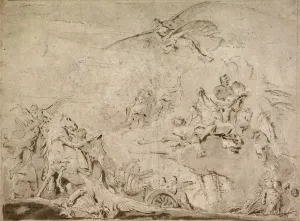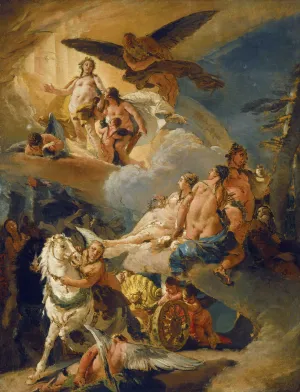Works Previously Associated with Palazzo Archinto
School of Giambattista Tiepolo (1696–1770)
Apollo and Phaëton, ca. 1730–40
Pen and brown ink over a black chalk sketch, brown watercolor and white lead on gray-green paper
15 1/4 × 20 1/2 in. (386 × 521 mm)
The British Museum, London
© Trustees of the British Museum
Traditionally attributed to Tiepolo and linked to his frescoes at Palazzo Archinto, this drawing seems to be an independent work not directly related to the Milanese fresco cycle or the Los Angeles sketch. The quality of the drawing is inferior to that usually achieved by Tiepolo. It may have been executed by Francesco Zugno, who worked alongside Tiepolo on the Rerum Italicarum Scriptores in the early 1730s.
Giambattista Tiepolo (1696–1770)
Apollo and Phaëton, ca. 1730–35
Oil on canvas
26 3/4 × 20 7/8 in. (68 × 53 cm)
Gemäldegalerie der Akademie der bildenden Künst, Vienna
Gemäldegalerie der Akademie der bildenden Künste Wien
This painting depicts the same episode shown in the Archinto ceiling. Here, the principal grouping of Apollo and his son Phaëton appears at the top left. Apollo stands on a cloud, while Phaëton kneels in front of him, holding a torch. Above them, Time flies inexorably. On the right are the Four Seasons, not dissimilar in composition from the Archinto fresco. Below them, the Hours tether two horses to the gold chariot of the Sun. A younger winged figure appears at the top, pouring water out of a vase and extinguishing a torch. This is probably Lucifer, the morning star.
Giambattista Tiepolo (1696–1770)
Apollo and Phaëton, ca. 1735–40
Oil on canvas
38 5/8 × 29 in. (98.1 × 73.6 cm)
The Bowes Museum, Barnard Castle, County Durham, United Kingdom
This painting depicts the same episode that Tiepolo frescoed on one of the five ceilings of Palazzo Archinto. Apollo, draped in red, holds a small vase with the ointment that was to protect his son's face while driving the chariot of the Sun. A Cupid flies into the composition, bringing Apollo his lyre. In the background, to the right, are the Four Seasons. Below, the Hours and a Cupid tie the horses to the gold chariot, though here, with its large wheels, it is closer to a country buggy. In the distant background, to the right, is Morpheus, asleep, with a bat flying overhead.



